Abstract
Microorganisms oxidize many aromatic compounds through the dihydroxylated intermediates catechol and protocatechuate and through the beta-ketoadipate pathway. The catabolic sequences used by the yeast Rhodotorula graminis for the dissimilation of aromatic compounds were elucidated after biochemical analysis of pleiotropically negative mutant strains. Growth properties of one mutant strain revealed that benzoate-4-hydroxylase was required for the utilization of phenylalanine, mandelate, and benzoate. Analysis of benzoate-4-hydroxylase- and p-hydroxybenzoate hydroxylase-deficient mutants provided genetic evidence that benzoate was hydroxylated in the para position forming p-hydroxybenzoate. Enzyme assays and growth studies with wild-type and mutant strains of R. graminis indicated that separate and highly specific hydroxylases oxidized p-hydroxybenzoate and m-hydroxybenzoate to protocatechuate. Examination of a protocatechuate 3,4-dioxygenase-deficient mutant demonstrated the role of the protocatechuate branch of the eucaryotic beta-ketoadipate pathway for the utilization of phenylalanine, mandelate, benzoate, and m-hydroxybenzoate. Salicylate, on the other hand, was shown to be metabolized through catechol. Thus, R. graminis differs from other yeasts such as Trichosporon cutaneum and Rhodotorula mucilaginosa in that it contains both branches of the beta-ketodipate pathway.
Full text
PDF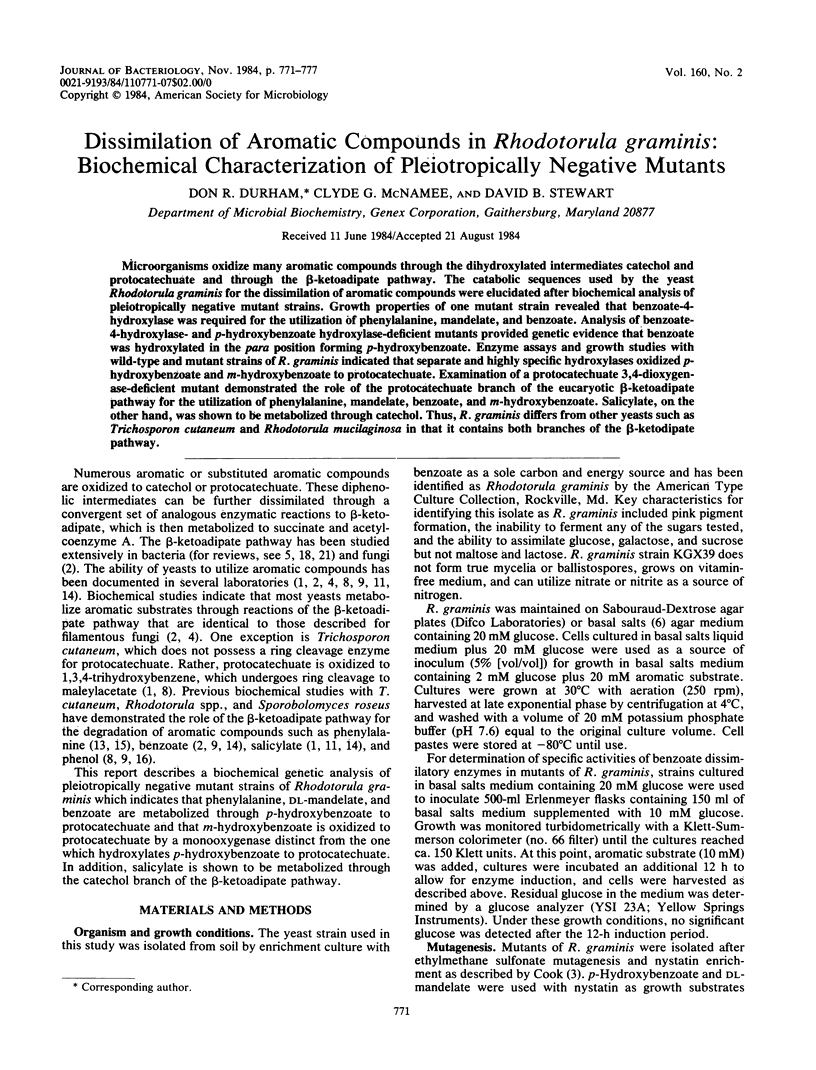
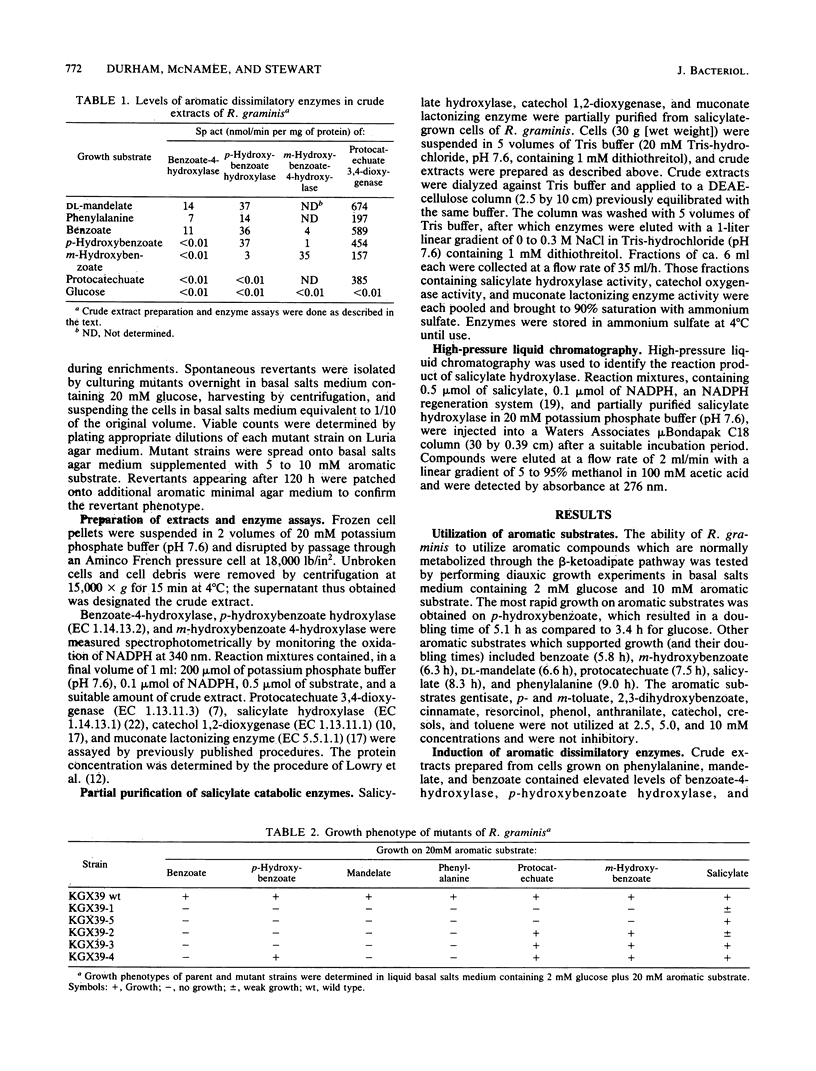
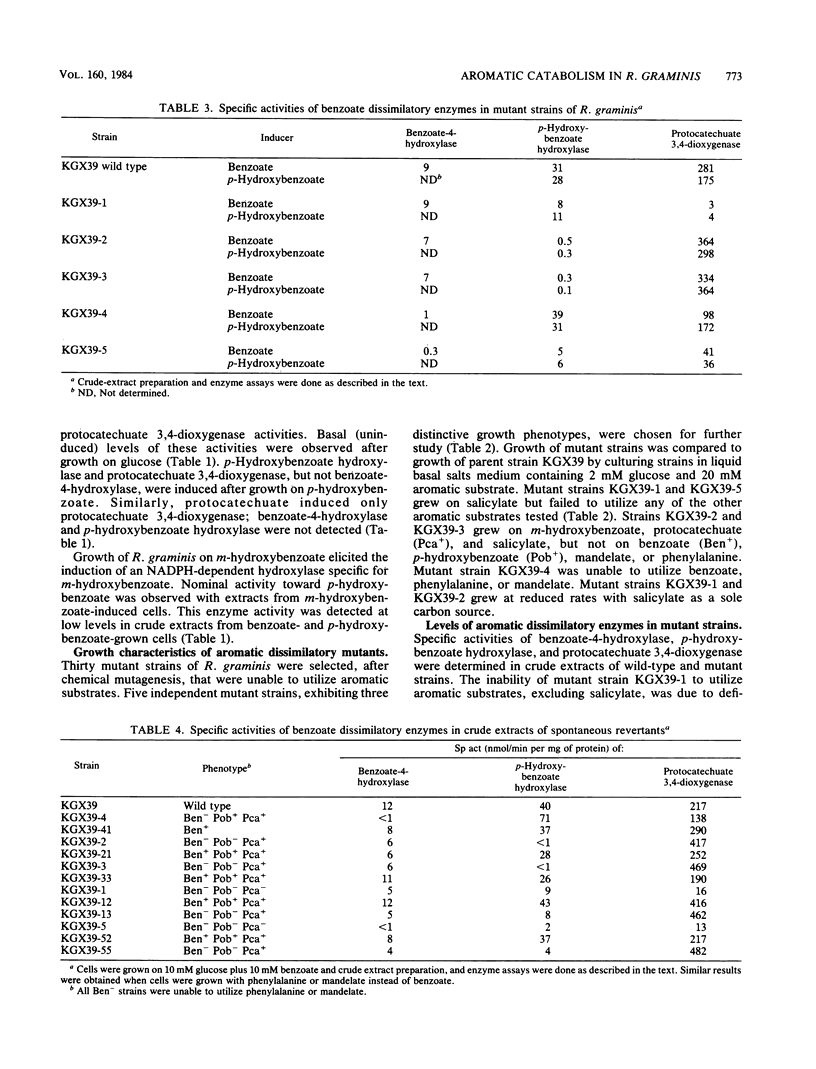
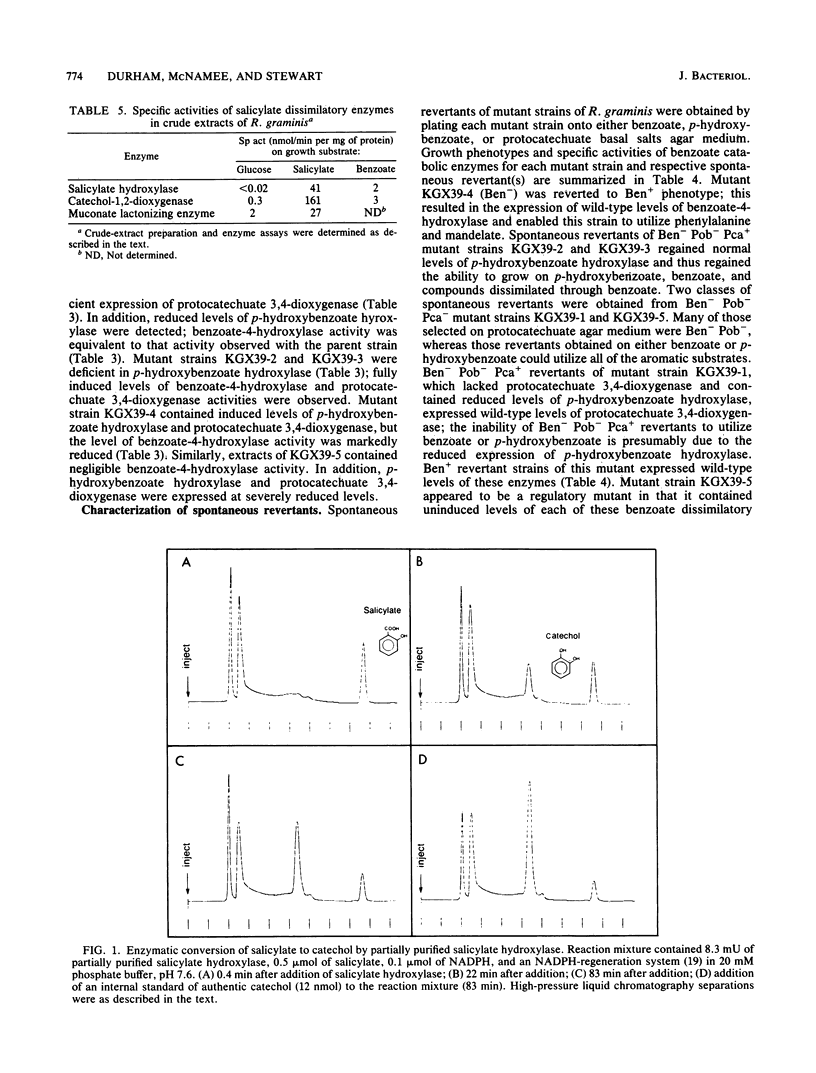
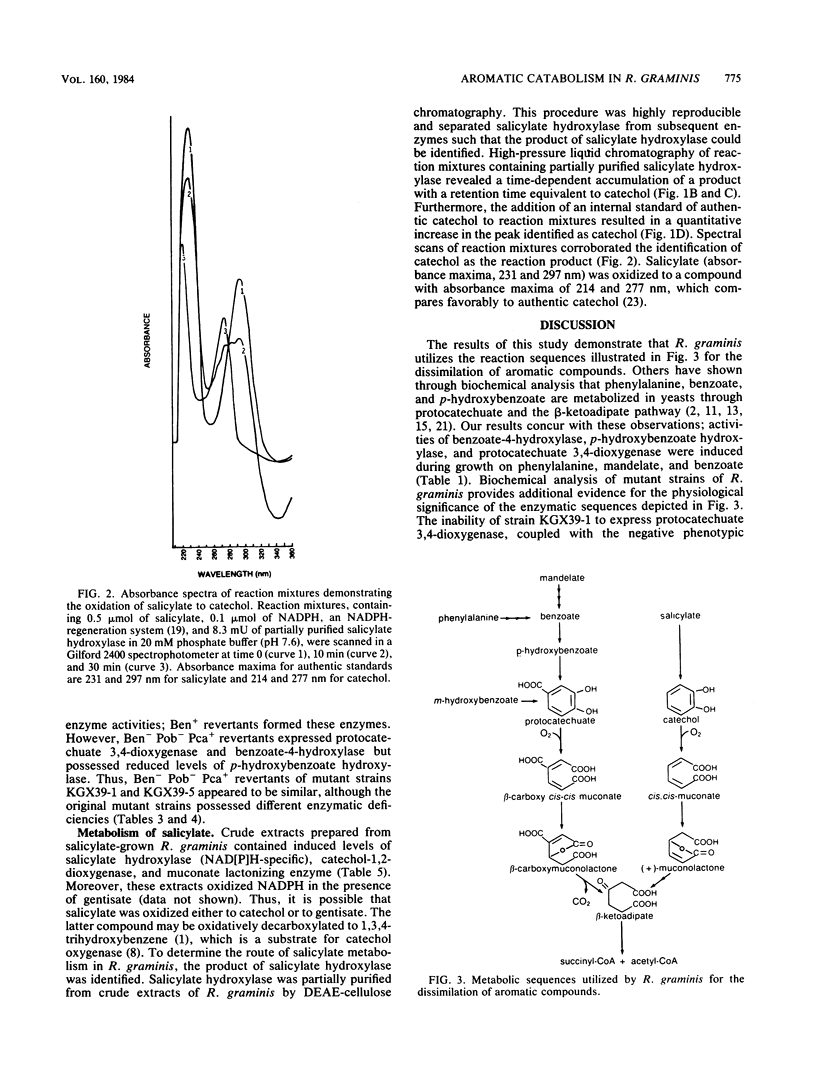
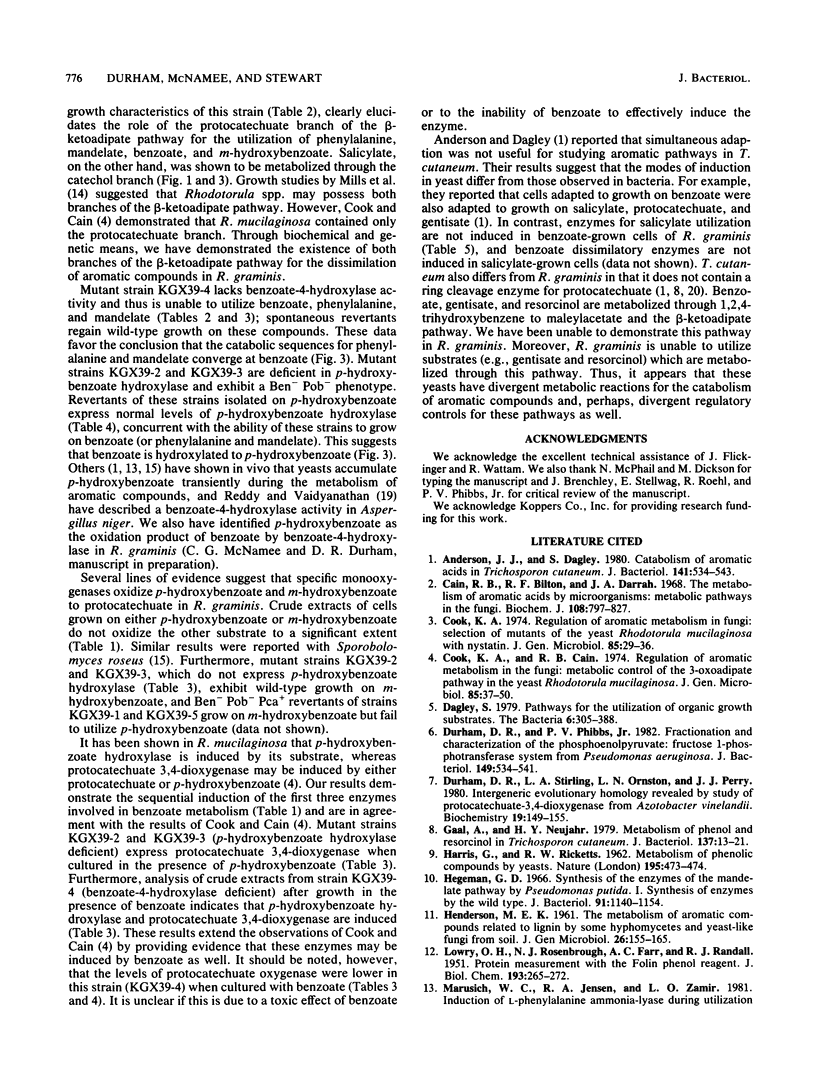
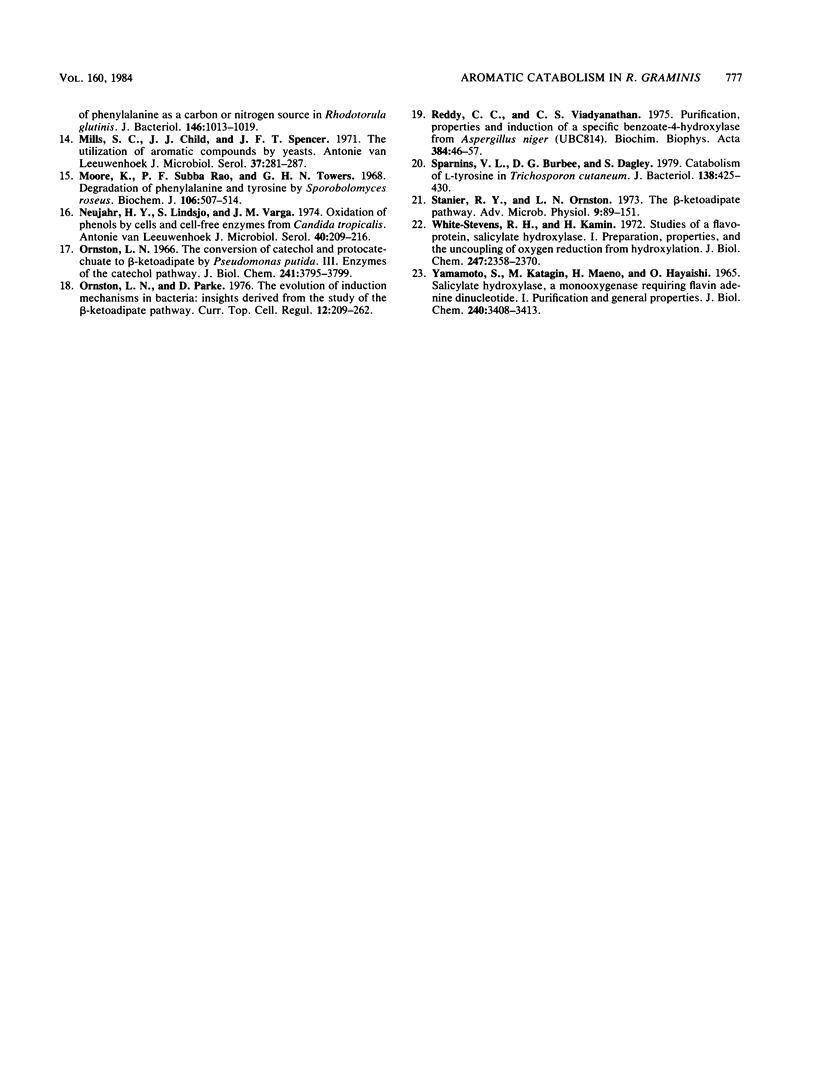
Selected References
These references are in PubMed. This may not be the complete list of references from this article.
- Anderson J. J., Dagley S. Catabolism of aromatic acids in Trichosporon cutaneum. J Bacteriol. 1980 Feb;141(2):534–543. doi: 10.1128/jb.141.2.534-543.1980. [DOI] [PMC free article] [PubMed] [Google Scholar]
- Cain R. B., Bilton R. F., Darrah J. A. The metabolism of aromatic acids by micro-organisms. Metabolic pathways in the fungi. Biochem J. 1968 Aug;108(5):797–828. doi: 10.1042/bj1080797. [DOI] [PMC free article] [PubMed] [Google Scholar]
- Cook K. A., Cain R. B. Regulation of aromatic metabolism in the fungi: metabolic control of the 3-oxoadipate pathway in the yeast Rhodotorula mucilaginosa. J Gen Microbiol. 1974 Nov;85(1):37–50. doi: 10.1099/00221287-85-1-37. [DOI] [PubMed] [Google Scholar]
- Cook K. A. Regulation of aromatic metabolism in fungi: selection of mutants of the yeast Rhodotorula mucilaginosa with nystatin. J Gen Microbiol. 1974 Nov;85(1):29–36. doi: 10.1099/00221287-85-1-29. [DOI] [PubMed] [Google Scholar]
- Durham D. R., Phibbs P. V., Jr Fractionation and characterization of the phosphoenolpyruvate: fructose 1-phosphotransferase system from Pseudomonas aeruginosa. J Bacteriol. 1982 Feb;149(2):534–541. doi: 10.1128/jb.149.2.534-541.1982. [DOI] [PMC free article] [PubMed] [Google Scholar]
- Durham D. R., Stirling L. A., Ornston L. N., Perry J. J. Intergeneric evolutionary homology revealed by the study of protocatechuate 3,4-dioxygenase from Azotobacter vinelandii. Biochemistry. 1980 Jan 8;19(1):149–155. doi: 10.1021/bi00542a023. [DOI] [PubMed] [Google Scholar]
- Gaal A., Neujahr H. Y. Metabolism of phenol and resorcinol in Trichosporon cutaneum. J Bacteriol. 1979 Jan;137(1):13–21. doi: 10.1128/jb.137.1.13-21.1979. [DOI] [PMC free article] [PubMed] [Google Scholar]
- HENDERSON M. E. The metabolism of aromatic compounds related to lignin by some hyphomycetes and yeast-like fungi of soil. J Gen Microbiol. 1961 Sep;26:155–165. doi: 10.1099/00221287-26-1-155. [DOI] [PubMed] [Google Scholar]
- Hegeman G. D. Synthesis of the enzymes of the mandelate pathway by Pseudomonas putida. I. Synthesis of enzymes by the wild type. J Bacteriol. 1966 Mar;91(3):1140–1154. doi: 10.1128/jb.91.3.1140-1154.1966. [DOI] [PMC free article] [PubMed] [Google Scholar]
- LOWRY O. H., ROSEBROUGH N. J., FARR A. L., RANDALL R. J. Protein measurement with the Folin phenol reagent. J Biol Chem. 1951 Nov;193(1):265–275. [PubMed] [Google Scholar]
- Marusich W. C., Jensen R. A., Zamir L. O. Induction of L-phenylalanine ammonia-lyase during utilization of phenylalanine as a carbon or nitrogen source in Rhodotorula glutinis. J Bacteriol. 1981 Jun;146(3):1013–1019. doi: 10.1128/jb.146.3.1013-1019.1981. [DOI] [PMC free article] [PubMed] [Google Scholar]
- Mills S. C., Child J. J., Spencer J. F. The utilization of aromatic compounds by yeasts. Antonie Van Leeuwenhoek. 1971;37(3):281–287. doi: 10.1007/BF02218497. [DOI] [PubMed] [Google Scholar]
- Moore K., Rao P. V., Towers G. H. Degradation of phenylalanine and tyrosine by Sporobolomyces roseus. Biochem J. 1968 Jan;106(2):507–514. doi: 10.1042/bj1060507. [DOI] [PMC free article] [PubMed] [Google Scholar]
- Neujahr H. Y., Lindsjö S., Varga J. M. Oxidation of phenols by cells and cell-free enzymes from Candida tropicalis. Antonie Van Leeuwenhoek. 1974;40(2):209–216. doi: 10.1007/BF00394378. [DOI] [PubMed] [Google Scholar]
- Ornston L. N., Parke D. The evolution of induction mechanisms in bacteria: insights derived from the study of the beta-ketoadipate pathway. Curr Top Cell Regul. 1977;12:209–262. doi: 10.1016/b978-0-12-152812-6.50011-1. [DOI] [PubMed] [Google Scholar]
- Ornston L. N. The conversion of catechol and protocatechuate to beta-ketoadipate by Pseudomonas putida. 3. Enzymes of the catechol pathway. J Biol Chem. 1966 Aug 25;241(16):3795–3799. [PubMed] [Google Scholar]
- Reddy C. C., Vaidyanathan C. S. Purification, properties and induction of a specific benzoate-4-hydroxylase from Aspergillus niger (UBC 814). Biochim Biophys Acta. 1975 Mar 28;384(1):46–57. doi: 10.1016/0005-2744(75)90094-7. [DOI] [PubMed] [Google Scholar]
- Sparnins V. L., Burbee D. G., Dagley S. Catabolism of L-tyrosine in Trichosporon cutaneum. J Bacteriol. 1979 May;138(2):425–430. doi: 10.1128/jb.138.2.425-430.1979. [DOI] [PMC free article] [PubMed] [Google Scholar]
- Stanier R. Y., Ornston L. N. The beta-ketoadipate pathway. Adv Microb Physiol. 1973;9(0):89–151. [PubMed] [Google Scholar]
- White-Stevens R. H., Kamin H. Studies of a flavoprotein, salicylate hydroxylase. I. Preparation, properties, and the uncoupling of oxygen reduction from hydroxylation. J Biol Chem. 1972 Apr 25;247(8):2358–2370. [PubMed] [Google Scholar]
- YAMAMOTO S., KATAGIRI M., MAENO H., HAYAISHI O. SALICYLATE HYDROXYLASE, A MONOOXYGENASE REQUIRING FLAVIN ADENINE DINUCLEOTIDE. I. PURIFICATION AND GENERAL PROPERTIES. J Biol Chem. 1965 Aug;240:3408–3413. [PubMed] [Google Scholar]


